
The greatest minds on Earth have all been busy figuring out the form and nature of extraterrestrial beings in our galaxy since the ancient of times. While there are potentially hundreds of thousands of habitable galaxy in our galaxy, it's quite difficult to predict what the aliens are like. However, we have come close to that answer.
As per a study by researchers from Oxford University all alien lives are subject to the same basic forces of natural selection as we are. So, it appears that we are not going to be that different from our neighbours in space.
The researh paper, 'Darwin's aliens,' published in the International Journal of Astrobiology by Oxford University researchers, argues that the evolutionary theory can be applied impartially to predict what life may be like on other planets. The International Journal of Astrobiology is a peer-reviewed scientific journal, published by Cambridge University Press.
"Without natural selection, (life) won't acquire apparently purposeful traits like metabolism, movement or senses. It won't be able to adapt to its environment, and in the process, become a more complex, noticeable and interesting thing," reads the research paper.
Life suffers very similar challenges, which range from efficiently distributing a sun's heat around a body through to needing to manipulate objects. The response to these challenges might just be as similar out there on other planets as it is on planet Earth.
"In our paper, we offer an alternative approach, which is to use evolutionary theory to make predictions that are independent of Earth's details," says lead researcher Sam Levin from Oxford's Department of Zoology. "This is a useful approach, because theoretical predictions will apply to aliens that are silicon-based, do not have DNA, and breathe nitrogen, for example," Levin adds.
The team of researchers highlights in their study how evolution on Earth records a plethora of explosions in species complexity, contrary to a gradual series of changes of time. These evolutionary 'transitions' frequently followed a natural cataclysm or a single significant shift in biological complexity. Essentially, it occurs when individual organisms come together to form a higher-level entity to deal with an external challenge.
For example, around 650 million years ago the melting of an enormous ice age, which covered the Earth, is believed to have released a wealth of nutrients into the oceans. Recently, evidence has been gathered from the sedimentary rocks in Outback Australia, which indicate this phenomenon had spurred a biological explosion, including the first appearance of photosynthesising organisms. Single-cell organisms evolved into multicellular organisms.
"It was a revolution of ecosystems, it was the rise of algae," researcher Jochen Brocks from ANU had said earlier this year.
According to the Oxford researchers, the challenge here is to identify the types of similar planetary events that could act as evolutionary triggers across the planets in our galaxy. They suggest that major transitions are likely to be the route to complexity on other planets. These events largely look like what we have already faced on Earth, such as Ice ages, co-operating cells, comet strikes and so on. These proceedings trigger the need to adapt to the changed conditions.
"By predicting that aliens have undergone major transitions — which is how complexity has arisen in species on Earth, we can say that there is a level of predictability to evolution that would cause them to look like us," says Levin.
"If you are picturing anything more complex or purposeful than a simple molecule, then the alien you are picturing has undergone natural selection," the paper reads.
However, it certainly does not mean that searching for alien life forms in the galaxy will be similar to looking into the mirror. But it essentially means that life will 'make sense', adopting many of the same features that led to our own climb up the evolutionary ladder.
"The challenge comes at the boundaries, for example between a virus and a cell, where the definitions become murky. We are not focusing on the boundaries, but things, like the vast majority of life on the Earth, which clearly have a multitude of parts working in concert," reads the paper.
Also read: Is India hiding some alien contact mystery from public?
"We still can't say whether aliens will walk on two legs or have big green eyes. But we believe evolutionary theory offers a unique additional tool for trying to understand what aliens will be like, and we have shown some examples of the kinds of strong predictions we can make with it," Levin says.
Everything, however, boils down to one point - we need to first find them.









